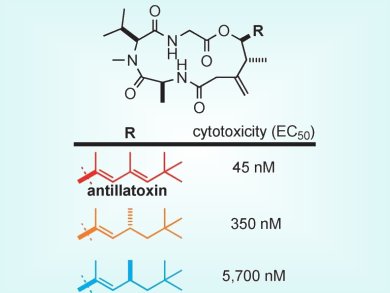Antillatoxin is a potent cytotoxin that activates voltage-gated sodium channels (VGSCs) in the membranes of nerve and other electrically responsive cells. This macrocyclic peptide is isolated from the marine cyanobacterium Lyngbya majuscula and, unusually, contains a terminal tert-butyl group. It is the orientation of this tert-butyl group that has now been discovered to be the secret to antillatoxin’s potency.
Ken Okura and Masayuki Inoue, University of Tokyo, Japan, synthesized analogues of antillatoxin with different dihedral angles between the tert-butyl group and the macrocycle. This was achieved by macrocyclization of a delta-hydroxycarboxylic acid derivative with a glycine, N-methyl-L-valine, and L-alanine tripeptide, then subsequently attaching the all-important tert-butyl-containing side chain.
The dihedral angle between the tert-butyl group and the macrocycle in antillatoxin is 60°. Increasing this angle to 140° causes toxicity to drop 15-fold. An analogue with a dihedral angle of 230° is 100 times less toxic than antillatoxin.
It is hoped that the discovery of this very pronounced structure-activity relationship will help in the understanding of VGSCs and their interactions with small molecules.
- The Orientation of the Terminal tBu Group of Antillatoxin is Important for Potent Toxicity: Design, Synthesis, and Biological Evaluation of Conformationally Restricted Analogues of Antillatoxin,
Ken Okura, Masayuki Inoue,
Asian J. Org. Chem. 2013.
DOI: 10.1002/ajoc.201300111




